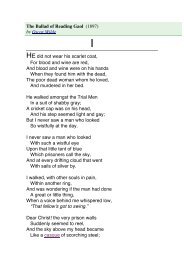Create successful ePaper yourself
Turn your PDF publications into a flip-book with our unique Google optimized e-Paper software.
when he took Ameri<strong>go</strong> Vespucci on board, but a very clever and very<br />
plausible landsman with a keen eye to his own interests.<br />
Alonzo de Hojeda left Cadiz, with four vessels, on May 20th, 1499.<br />
Endeavouring to steer by the chart of Columbus, he made a landfall at some<br />
distance to the south of Paria, off the mouths of the Orinoco. Coasting along<br />
to the northward, he came to the Gulf of Paria, went out by the Boca del<br />
Dra<strong>go</strong>, and visited the island of Margarita. He then proceeded along the<br />
coast of the continent, visited Curaçoa, which he called the "Isla de los<br />
Gigantes", and came to the Gulf of Maracaibo, where he found a village built<br />
on piles, which was named Venezuela, or Little Venice. His most western<br />
point was the province of Cuquibacoa and the Cabo de la Vela. His discovery<br />
consisted of 200 leagues of coast to the west of Paria. Along this coast<br />
Hojeda obtained <strong>go</strong>ld and pearls. He had an encounter with the natives, in<br />
which one Spaniard was killed and about twenty wounded, the place being<br />
named "Puerto Flechado". He refitted in a harbour where the people were<br />
friendly, and which Ameri<strong>go</strong> considered to be the best harbour in the world.<br />
Las Casas believed this to have been Cariaco, near Cumana. On leaving the<br />
coast Hojeda proceeded to Española, where he behaved in the outrageous<br />
manner described by Las Casas, 20 remaining two months and seventeen<br />
days, from September 5th, 1499, to November 22nd, finally visiting some<br />
islands, probably the Bahamas, 21 and carrying off 200 natives as slaves.<br />
Hojeda returned to Cadiz in February 1500. In the same year Juan de la<br />
Cosa, the pilot of the expedition, compiled his famous map of the world, on<br />
which he delineated this new coast-line from Paria to Cabo de la Vela, the<br />
extreme point of continental land that was known up to that time. On this<br />
coast-line he placed twenty-two names, including the Boca del Dra<strong>go</strong>,<br />
Margarita, the "Isla de los Gigantes", the Lake of Venezuela (or Little<br />
Venice), and the Cabo de la Vela. The map of Juan de la Cosa is important<br />
when we come to the consideration of the statements in the letters of<br />
Vespucci.





